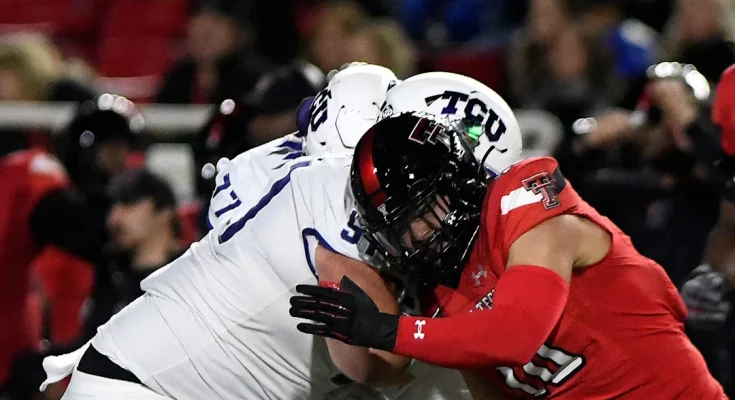Texas Tech University’s football program has long been a compelling story in the landscape of college football. The Red Raiders, hailing from Lubbock, Texas, have built a reputation for high-octane offenses, gritty underdog performances, and a passionate fan base that thrives on the thrill of competition. As the 2025 college football season approaches, Texas Tech finds itself in a precarious position in the preseason Top 25 rankings, teetering on the edge with only a razor-thin margin separating them from teams both above and below. This fragile positioning reflects the uncertainty surrounding the team’s roster, coaching strategies, and overall strength relative to a fiercely competitive landscape in the Big 12 and across the nation.
The preseason rankings are a product of careful analysis, speculation, and projection, blending the measurable with the intangible. For Texas Tech, the balance of measurable factors, such as returning starters, statistical performance from the previous season, and the incoming recruiting class, must be weighed alongside intangible elements like team chemistry, coaching adjustments, and the capacity for players to perform under pressure. The Red Raiders finished the 2024 season with moments of brilliance interspersed with stretches of inconsistency, a duality that often defines teams hovering on the cusp of national recognition. Analysts have taken note of the team’s explosive passing game, a hallmark of Texas Tech football, led by a quarterback who has shown flashes of elite skill but also moments of volatility. The offensive line has been a focal point of discussion, as the unit’s ability to protect the quarterback and create lanes for the running game will be a key determinant in the team’s ability to ascend the rankings once the season begins.
Recruiting has become a critical factor in shaping the perception of Texas Tech as a Top 25 contender. The 2025 recruiting class brought a blend of highly-rated prospects and overlooked talents who could emerge as difference-makers. Recruiting success does not guarantee immediate impact, yet the infusion of new talent adds depth and competition to the roster, which can translate to improved performance in high-stakes games. Observers of the Red Raiders have noted that the coaching staff, under the leadership of a head coach who has emphasized adaptability and innovation, has maximized the potential of previous recruiting classes and may be poised to do the same with this cohort. The preseason rankings, however, remain skeptical. Teams on the fringe of the Top 25 often face scrutiny not just for their capabilities but for the uncertainty surrounding their consistency and ability to navigate the challenges of a full season.
The razor-thin margin for Texas Tech in the preseason rankings is also influenced by the broader dynamics of the college football landscape. The Big 12 Conference has become increasingly competitive, with multiple programs showing the ability to challenge for conference supremacy. The addition of transfer players across the league, the evolution of offensive and defensive schemes, and the unpredictability of injury and player development contribute to the volatility of rankings at this time of year. For Texas Tech, every element of preparation, from strength and conditioning to film study, will play a role in whether the team can maintain or improve its standing as the season unfolds. Analysts are particularly focused on the early-season schedule, as opening games against ranked or traditionally strong opponents could either cement the Red Raiders’ reputation or expose vulnerabilities that threaten their Top 25 status.
Beyond the numbers and predictions, the intangible qualities of Texas Tech’s football program cannot be overlooked. The culture of resilience, the passionate fan base, and the history of overcoming adversity contribute to a sense of identity that analysts sometimes struggle to quantify. Players entering their second, third, or fourth seasons with the program often speak to the pride and responsibility they feel wearing the Red Raiders’ uniform. These intangibles, while difficult to measure statistically, can manifest in critical moments on the field, whether in executing a game-winning drive, making a pivotal defensive stop, or sustaining momentum in a tightly contested game. For a team hovering at the edge of the Top 25, such qualities can be the difference between cracking the rankings or falling just outside of national recognition.
In addition to the physical and cultural aspects, coaching strategy will play a pivotal role in Texas Tech’s ability to navigate the precarious preseason ranking. The Red Raiders’ coaching staff has emphasized a balance between an aggressive, high-scoring offense and a disciplined, opportunistic defense. Adjustments from game to game, player development, and the integration of new talent are all areas where coaching decisions can have outsized impacts on the team’s performance. Analysts scrutinize the coaching staff’s history of innovation, adaptability, and in-game decision-making when considering Texas Tech’s potential to maintain a spot in the Top 25. The razor-thin margin for the Red Raiders means that even small lapses or miscalculations could have outsized consequences on national perception and postseason prospects.
Another key element affecting Texas Tech’s standing is the quarterback position, often the focal point of a team’s identity and success. The Red Raiders have demonstrated a willingness to embrace dynamic playmakers capable of stretching defenses both vertically and horizontally. The quarterback’s ability to read defenses, make split-second decisions, and execute under pressure is crucial in maintaining competitiveness in a conference filled with high-powered offenses. Returning starters and experienced skill position players provide continuity, but the development of young talent and the integration of transfers can alter the offensive scheme in ways that either solidify or destabilize the team’s effectiveness. Analysts and fans alike watch closely how these variables unfold during training camp and preseason games, as they serve as early indicators of whether Texas Tech can sustain momentum into the regular season.
Defense, often a point of concern for teams on the fringe of the Top 25, also plays a significant role in Texas Tech’s positioning. The Red Raiders have historically been known for their offensive firepower, but maintaining competitiveness requires a complementary defensive unit capable of limiting big plays and creating turnovers. The defensive line, linebackers, and secondary must work cohesively to pressure opposing quarterbacks, defend the run, and disrupt timing in the passing game. Depth across defensive positions is particularly important given the physical toll of a long season and the likelihood of injuries. Observers note that the effectiveness of the defense may ultimately determine whether Texas Tech can convert close games into victories, a factor that heavily influences rankings and national perception.
Special teams, though sometimes overlooked in ranking discussions, can also tip the scales for a team like Texas Tech. Field position, kick returns, and the ability to convert scoring opportunities efficiently all contribute to the overall performance profile of the team. A single blocked kick, a long punt return, or a clutch field goal can shift the outcome of a game and, by extension, influence the Red Raiders’ standing in the eyes of voters. Preseason assessments often take into account the reliability and potential of special teams units, particularly for teams on the edge of the Top 25, where margins between recognition and obscurity are narrow.
The human element cannot be ignored. Players, coaches, and fans experience a unique psychological dynamic when a team hovers near the edge of national recognition. Motivation, confidence, and mental toughness become intertwined with physical performance. The Red Raiders’ ability to embrace the challenge, manage expectations, and maintain focus amidst media scrutiny and public debate may well define their trajectory during the early weeks of the season. Every practice, adjustment, and decision carries added weight when the margin separating them from the rest of the country is so slim. The resilience of the team, both individually and collectively, is therefore a vital factor in their potential success.
In broader context, the razor-thin margin of Texas Tech’s preseason ranking illustrates the complexity and subjectivity of evaluating college football programs before a single game has been played. Rankings are inherently predictive and speculative, relying on historical performance, perceived talent, coaching pedigree, and projected growth. For Texas Tech, being on the edge of the Top 25 means they are simultaneously recognized for their potential while being reminded of the volatility inherent in college athletics. A strong start to the season could propel the Red Raiders upward, while early missteps could quickly drop them from national consideration, demonstrating the delicate balance that defines preseason projections.
As the 2025 season approaches, Texas Tech’s positioning on the cusp of the Top 25 carries both pressure and opportunity. The Red Raiders have the chance to prove that the preseason skepticism is unfounded, showcasing their offensive prowess, defensive cohesion, and overall team resilience. Every practice, strategy session, and game preparation becomes magnified in significance. For fans and analysts alike, the story of Texas Tech represents the broader narrative of college football: a dynamic, unpredictable sport where preparation, talent, and heart intersect to define success. The razor-thin margin that separates the Red Raiders from other teams in the rankings serves as a reminder that in college football, every detail matters and small differences can have monumental impacts on the national stage.
Ultimately, Texas Tech’s journey this season is about more than just rankings; it is about proving identity, building cohesion, and embracing the challenge of competing at the highest level. The Red Raiders’ ability to maintain focus, leverage talent, and adapt strategically will determine whether they move from the edge of the Top 25 to a position of solidified national recognition. In a sport defined by passion, unpredictability, and the pursuit of excellence, Texas Tech stands poised to demonstrate resilience and ambition. The razor-thin margin in the preseason rankings highlights both the uncertainty and the potential, setting the stage for a season where every snap, play, and decision could tip the balance between fleeting recognition and lasting achievement. The eyes of fans, analysts, and rivals alike will remain fixed on Lubbock as the Red Raiders embark on this pivotal chapter in their storied football history, striving to turn potential into tangible success and prove that they belong among college football’s elite.



